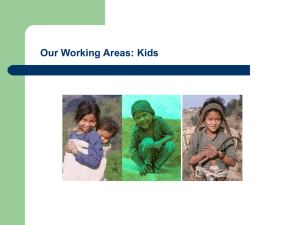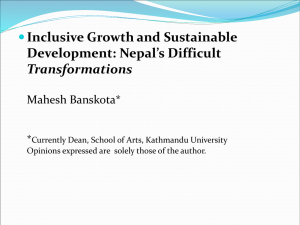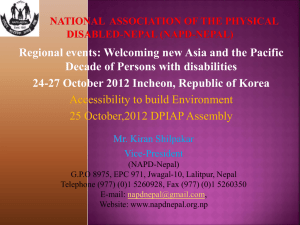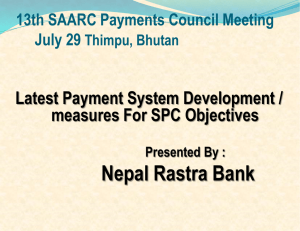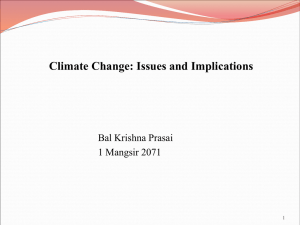accreditation of technical education and vocational training in
advertisement
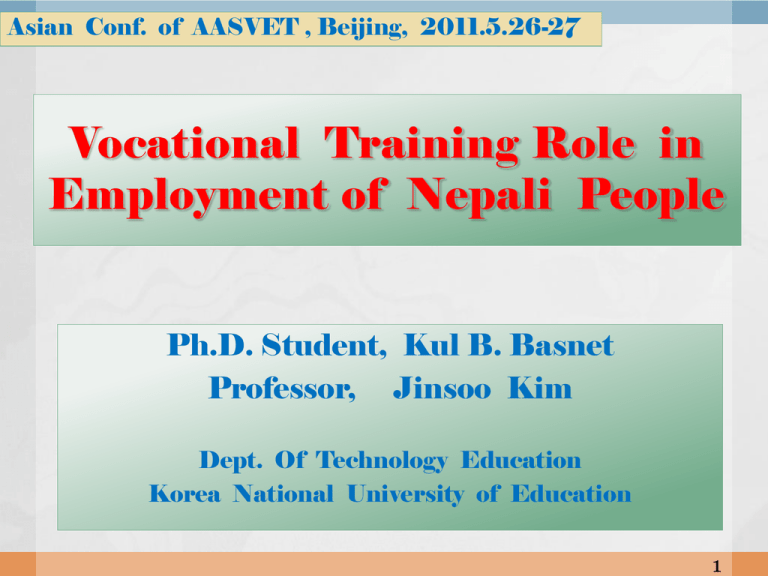
Asian Conf. of AASVET , Beijing, 2011.5.26-27 Vocational Training Role in Employment of Nepali People Ph.D. Student, Kul B. Basnet Professor, Jinsoo Kim Dept. Of Technology Education Korea National University of Education 1 OUTLINE I II III IV V VI • INTRODUCTION • SOCIO-ECONOMIC CONTEXT • EMPLOYMENT SITUATION • VOCATIONAL TRAINING and PROGRAM • CONSTRAINTS and OBSTACLES • CONCLUSION 2 I. INTRODUCTION Vocational Education & Training (VET) Help to young professional to move from school environment to world of work. Can develop appropriate skills, improve labor supply and employability of the workforce. Economic environment determine size and nature of skill; benefit of training. Responsibility of planners linking training with economic productivity. 3 In Nepal number of non-skilled youth and educated unemployed are increasing fast. New job related with IT and computer are growing fast; and channeling unskilled workers into new growth area is not happening. Sustained and consolidated effort is needed. 4 Nepal Responsible institute should come up with consolidated policy and program to create job in market. To link vocational training with employment, active participation of business and industry is essential. 5 PURPOSE Discuss current employment situation and role of vocational training in employment in Nepal. 6 NEPAL Situation Nepal workforce lacks productivity because of skill training Foreign employment – provide skill training before going – could easily increase annual income Gap between vocational training program and employment 7 REASON OF STUDY Vast number of adults have either not been to school or not received any vocational training. As a result workforce lacks productivity in domestic as well as in overseas labor markets. 8 RESEARCH FRAMEWORK Qualitative method Examination of written documents Descriptive analysis Authors individual experience and observation 9 II. SOCIO-ECONOMIC CONTEXT Mosaic of culture, language and religion Economy-labor intensive Ethnic group – 101 Land fragmentation Language Sharp rise of inequality - 92 10 BASIS OF ECONOMY Labor intensive agriculture Cultivating fragile soils Raising livestock for low returns 11 FARM LAND OWNERSHIP AND DISTRIBUTION S.N. Holdings 1 <0.50 ha Percent Holdings 46.93 Percent Area (ha) 14.7 2 <1.00 – 0.50 ha 27.22 24.18 3 >1 ha 25.85 61.12 Source: Central Bureau of Statistics, 2001 (Agriculture Census) 12 ECONOMIC DEVELOPMENT PERFORMANCE Srilanka 1960 NEPAL 2009 Bhutan 1980 HDI-2.4% Rank-138 (169) Pakistan 1970 Inequality - 0.41 India 1980 13 POPULATION AGED 15 & OVER LEVEL OF COMPLETED EDUCATION Description Male (%) Female(%) Total (%) Never attend school 32.4 58.2 46.7 Less than primary 13.2 8.8 10.7 Primary 16.7 10.9 13.5 Lower secondary 11.2 7.0 8.9 Secondary 17.0 10.4 13.4 Higher secondary 5.4 2.9 4.0 Bachelors and Masters 3.3 0.9 2.0 Others 0.7 0.8 0.7 Not stated 0.1 0.1 0.1 Source: Nepal Labor Force Survey– 2008 14 III. EMPLOYMENT SITUATION Agricultur e – 73.9% Nonagriculture – 26.1% Paid employees - 16.9% Population employment ratio – 81.7% 15 LABOR FORCE Growth rate – 2.6% Agriculture – give 90 days work/yr • 1-19hrs-11% • 20-39 hrs-20% • 40 hrs more68% Employment Unemployment • Urban-14.2% • Rural-4.2% • Rural -32.51% • Urban-29.25% • Total – 42% Under employment 16 FOREIGN EMPLOYMENT Cumulative number Going out for employment Countrywide data (2009/2010) Year Number Year Number Country Name Number of people 2001 250,000 2006/07 204,533 Malaysia 113,900 Saudi Arab 63,700 Qatar 57,340 UAE 33,840 2007 500,000 2007/08 249,051 2008 800,000 2008/09 219,965 Kuwait 8,255 2011 1,200,000 projected 2011 projected 294,094 Oman 3,285 Others 13’744 Source: Department of Foreign Employment Promotion 17 IV. VOCATIONAL TRAINING PROGRAM Ministries CTEVT NGOs Participatory District Development Program Vocational Training and Community Development Program Training for Employment Department of Labor Department of Cottage & Small Industry Training Institute Skills for Employment Project F-skill Rural Development Bank 18 V. CONSTRAINTS & OBSTACLES 2. Access/ Resources 1. Gap between policies, plans, programs and implementation Labor Market Rigidities 4. Weak Governance 3. Political Stability 5. Infrastructure shortcomings 19 VI. CONCLUSION VET 1 2 Develop model giving value to vocational training and skills. Give opportunity to school dropout and rural people. 3 Adopt rapidly changing demands of labor market 20 REFERENCES ADB, DFID & ILO. (2009). Country Diagnostics Studies Highlights Nepal: Critical Development Constraints. Central Bureau of Statistics, Government of Nepal. (2004). Nepal Living Standard Survey 2003/04. Central Bureau of Statistics. (2009). Report on the Nepal Labor Force Survey 2008.National Planning Commission Secretariat, Government of Nepal. National Planning Commission. (2005). Implementation of the Brussels Program of Action for the LDCs for the Decade 2001 – 2010. Progress Report Nepal. 21 THANK YOU 22

